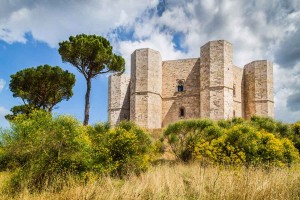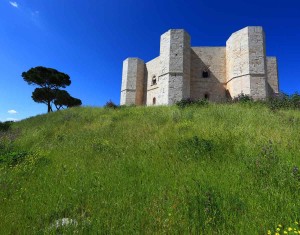
©Bigstock.com/Ibryan
An octagonal fortress that, to this day, poses many a riddle rises on a hill near Andria in southeast Italy. Castel del Monte, the “Castle of the Mountain” surprises with its unorthodox shape, the mix of various architectural styles and a very meagre interior. Built during the reign of Emperor Fredrick II, it held a special place among his great number of castles in Apulia and was eventually declared World Heritage Site by the UNESCO in 1996. We don’t know about you, but that sounds like reason enough to take a look at – and inside – this fascinating building.
Fredrick II and Italy
King of Sicily at age 3, King of Germany and Italy at age 18, Holy Roman Emperor soon after – Frederick II from the House of Hohenstaufen experienced a tremendous amount of power very early. He became an orphan as a toddler and was placed under the guardianship of Pope Innocent III, survived all power struggles, stabilised his empire and tried to lead it to renewed brilliance.
Frederick took a particular liking to Italy, where he spent 28 of his 39 years in power, stabilised Sicily, extended his empire and even secured the borders of the Northern Alps. His focus, however, was on the south of the country, which he continuously strengthened and fortified. Apulia, in particular, saw the construction of several castles and fortresses. They clearly followed contemporary ideas yet were visibly influenced by Frederick’s travels and his Crusade. Still, Castel del Monte manages to stick out from this architectural plurality.
What’s behind this castle?
It is unknown why Castel del Monte has its special shape. We neither know its original purpose. Located in the heart of a very fertile region in close proximity to the monastery Santa Maria del Monte, it was built on the fully dissipated grounds of another fortress that has been lost to time. There’s only one single piece of documentation from the year 1240 containing instructions to complete the castle. Thus, it remains unknown whether Castel del Monte was actually used as the emperor’s hunting seat, as was the belief among experts for a long time.
While the castle is situated strategically well in good proximity to Frederik’s network of fortifications and not too far away from his other residences either, all defensive elements, such as cellar, moat and lift bridge, are missing. Castel del Monte is comparatively small – thus the hunting seat theory – but experts now think that some of the original walls were lost over the course of time and it might have, in fact, originally been a citadel. We probably will never learn the exact purpose of Castel del Monte, but that only makes your trip to this impressive structure more exciting.
The architecture

©Bigstock.com/bao
Castel del Monte looks like a mathematical miracle. The almost perfect octagon with a diagonal of 56 m was seemingly devised utilising strict mathematical and astrological – the octagonal form mediates between the circle (the infinite sky) and the square (the earth) – principles. Manifold light and shadow arrays unfold depending on the season and the position of the sun. You certainly won’t be the only one impressed as scientists have been working for centuries to decipher the riddle behind these arrays, if there even is one.
Matching the eight-corner construction, the fort features eight towers – octagonal as well – and eight halls. Experts assume that the courtyard used to contain an octagonal basin. Fredrick was likely inspired by the Dome of the Rock in Jerusalem or the octagonal Palace Chapel of Aachen Cathedral. This would explain the stylistic plurality of the imposing limestone building with ancient, gothic and Islamic elements.
A look inside
Before entering Castel del Monte, you should direct your full attention to the entrance portal. Made from the conglomerate Breccia rossa (“red breccia”), it sees the collision of all styles. Ancient pilaster framing, gothic capitals, the rectangular perimeter with Islamic influences, oriental play of colours and column figures from Apulian Romanesque architecture symbolise Frederick’s drive to fully unite the entire empire.
The inside of the castle, however, seems rather bare. Originally vested with precious marble, paintings, tapestry and mosaics, the rooms and halls were stripped of its splendour over the course of the centuries. Only the colourful marble frets on most of the doors remained. Experts believe that part of the materials were used to build other facilities while looters and vandals took the rest.
What you should also know about Castel del Monte
But why, of all structures, was Castel del Monte – absolutely well-deserved, as you will agree – declared UNESCO World Heritage Site? And what’s the castle’s role in viniculture? We’ve collected seven more facts for you:
- Grand: UNESCO’s reasoning behind declaring the castle World Heritage Site was the perfect synthesis of science, art and mathematics, the various stylistic influences and the exceptional role in medieval architecture.
- Panta rhei: Castel del Monte possessed what likely was the most advanced water installations of its time. Rain water was used for the toilets and baths.
- Mr X: It’s not just the exact purpose of the citadel that remains unknown; the architect itself couldn’t be determined either – one of many riddles surrounding this building.
- High arts: Matteo Garrone’s “Tale of Tales” a 2015 movie based on the 17th century fairy tale collection “Pentameron” by Italian writer Giambattista Basile, was filmed here. It is very likely that the aedificium from Umberto Eco’s “The Name of the Rose” was inspired by Castel del Monte.
- Fine wines: There’s a large vineyard around the castle producing different red wines, white wines and rosés. They are mostly high-quality blends of different grape varieties.
- Money, money, money: Have you ever flipped over an Italian 1 Cent coin? Castel del Monte is depicted on its back.
- Popular destination: It’s not just Apulians who love the fortress, but the entire country. The castle has been among the top 15 most popular Italian tourist destinations for years. Guided tours are offered throughout the entire year and cost € 10 on average.
Are you ready for a mysterious trip back in time? Castel del Monte invites you to a historical investigation having many a fascinating secret hidden behind its walls. Travel back to the Hohenstaufen era and explore the special charm of this legendary fortress in Apulia!